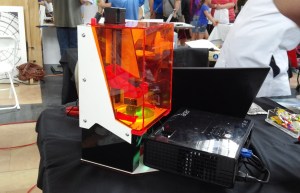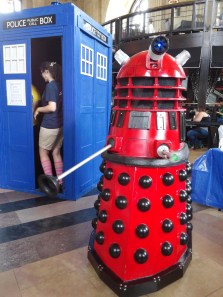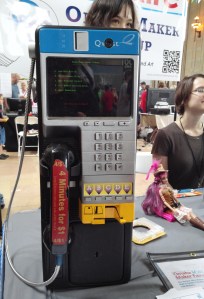What did you do over the weekend? I spent both days at Maker Faire Kansas City and it was awesome. This is the fourth year the Faire has been held in Union Station, a stunning Kansas City landmark that celebrates its centennial this fall.
The Things
As you might imagine, there were 3D printers galore. One of my favorites was the One Up family from Q3D. These acrylic beauties start at $199 and offer a heated bed plate option.
Maker Juice Labs, purveyors of 3D printing inks for SLA brought a LittleSLA printer which they demonstrated by making some very nice key chains.

Little SLA does it stereolithographically.
SeeMeCNC had their Rostock Max V2 printer cooking up some huge prints, and Oni Technology, a local KC company, had their H Bot cranking.

Locally-made Oni H Bot.
At the Modio booth, my companion and I constructed heroes and monsters from a rainbow-colored pile of 3D-printed body parts and weapons. With Modio's iPad app, you can create characters from the existing parts library, modify those parts, and print them on any 3D printer. All of the parts are designed to snap together. Modio recently teamed up with MakerBot and hopes to port their app from the iPad to the iPhone and Android in the near future.
I managed to resist the inexplicable Hostess booth and their free piles of Twinkies, Cup Cakes, and Coffee Cakes. They had a display that promised banana Twinkies and some Greek yogurt oddities, but only had the regular stuff on hand. On Sunday, I saw many people lugging around entire boxes of free Donettes and other goodies.
I could not resist a nearby booth that let me try out needle felting. If you're unfamiliar, this process involves a repetitive stabbing motion with a small and insanely sharp needle to marry wool fibers together into any shape you can conceive. I got the basic hang of it and definitely see myself picking up another hobby—it would be very fun to felt a creature and incorporate, say, blinky eyes or a tilt switch that makes it squawk.

Exterminate!
There was no end to the diversity of makers and their creations. I was nearly exterminated by a Dalek, but enlisted the aid of a nearby R2 unit. I saw scooters made from Adirondack chairs, complete bouquets made of fabric, hydroponic bucket gardens, jewelry, woodturnings, and networked music collaboration systems. I tasted blueberry jam that surprised me with its savory notes. I saw people walking around in freshly laser cut eyeglasses-and-moustache disguises and others wearing intricate makeup and costumes. There were steampunks, cosplayers, and superheroes galore.
The People
The lower level was dedicated to children and I almost didn't get down there. Boy, am I glad I did, because I got to meet [Sarah Hodsdon] of Sarahndipitous Designs. Let me tell you, this woman is the friendly, caffeinated, inspirational embodiment of the maker spirit. She and her three virtually educated kids had a long table covered with a paper timeline of the Maker Faire. They instructed fairegoers to make their mark by creating a stamp from an eraser and stamping the area of the timeline representing their visit. [Sarah] and her crew had paper on hand to wrap up inky stamp souvenirs.
![[Sarah] and her daughter brought their creative A-game.](http://hackadaycom.files.wordpress.com/2014/06/20140629_141043.jpg?w=223&h=300)
[Sarah Hodsdon] brought her creative A-game.
Late on Saturday afternoon, a thunderstorm drove everyone indoors. As [Sarah] pointed out, there were many time stamps on this part of the timeline. One woman had carved out a Tardis and made her mark far in the future.
[Sarah] is disappointed that cursive will no longer be taught in schools. As a result, part of her booth was dedicated to creating a handwritten copy of The Wizard of Oz one sentence at a time on yellow index cards. Her vision is that these cards would be laid out as a yellow brick road of penmanship and making.
The Maker Groups
Kansas City's hacker space, CCCKC had a booth in the main hall and were also running a Learn to Solder workshop on the lower level. They currently offer classes in game development, the Raspberry Pi platform, and Toki Pona [link], a minimalist language of fewer than 130 words.
Hammerspace was there as well with member [Michael]'s 3D-printed electric vehicle. This group has also printed a prosthetic hand for a 9-year-old boy and a replacement digit for an active duty soldier. They recently held a build workshop for Little Free Libraries.

They’re distracted! Run!
[Tom] of MakeICT, the maker space of Wichita, KS won a Maker of Merit ribbon for his foot-activated percussion tree of delight. They also brought a foam cutting bot and this fantastic drawing bot. I ran into [Dustin Evans] of tesseract replica fame, and I got to see it in person. He and [Nick Alexander], re-purposer of Wi-Fly helicopter receivers also brought a sweet homebrew arcade cabinet that attracted these unsavory characters. Surely it wasn't the huge Hackaday logo . . . or was it?
Also in attendance: Lawrence Creates maker space and center for innovation, an analog-leaning hive of creativity. Their members give classes in everything from sewing and silk screening to stone carving and stained glass.
The Free/Libre Open Source and Open Knowledge Association of Kansas was formed in 2012 to promote FLOSS and open knowledge in Kansas and beyond.
The KC Open Hardware Group will hold their second annual hardware conference this fall which aims to spread the gospel of the open source hardware movement. There will be a wide range of speakers, presentations, and smaller panels for demonstrations.
The Omaha Maker Group brought a hacked Qwest payphone that showed videos of their 'space, past events, and of course, their creations. I was treated to pleasant, danceable music through the receiver that went well with the montage of their community adventures.

Dial ‘A’ for Adventure.
Folks from Milwaukee Makerspace brought their souped up Power Wheels as did members of Area515 out of Des Moines, IA. Area515 also brought electric vehicles to display including an electric Miata and a modified Cushman truckster.
As I remarked to my companion, each aspect of the Faire seemed to be about three times larger than last year. I hope that it will continue to grow and keep inspiring people for years to come.











Filed under:
cons,
Featured 







![[Sarah] and her daughter brought their creative A-game.](http://hackadaycom.files.wordpress.com/2014/06/20140629_141043.jpg?w=223&h=300)














